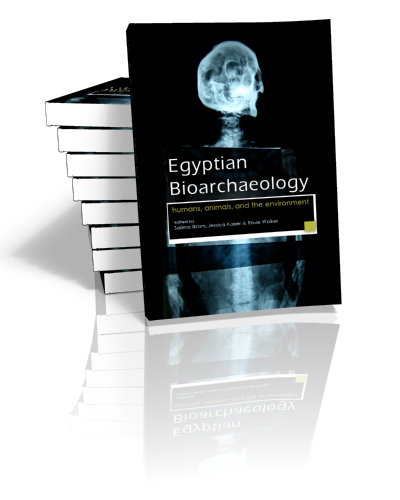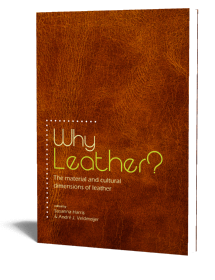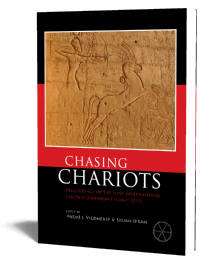Egyptian Bioarchaeology
Humans, Animals, and the Environment
Edited by Salima Ikram, Jessica Kaiser & Roxie Walker | 2015

Egyptian Bioarchaeology
Humans, Animals, and the Environment
Edited by Salima Ikram, Jessica Kaiser & Roxie Walker | 2015
Paperback ISBN: 9789088902871 | Hardback ISBN: 9789088903854 | Imprint: Sidestone Press | Format: 182x257mm | 248 pp. | Language: English | 46 illus. (bw) | 45 illus. (fc) | Keywords: ancient Egypt, archaeology, bioarchaeology, zoölogy, ecology, Egyptology, dendrochronology, radiology, physical anthropology, palaeopathology | download cover
Read online or downloaded 5448 times
-
Digital & Online access
This is a full Open Access publication, click below to buy in print, browse, or download for free.
-
Buy via Sidestone (EU & UK)
-
Buy via our Distributors (WORLD)
For non-EU or UK destinations you can buy our books via our international distributors. Although prices may vary this will ensure speedy delivery and reduction in shipping costs or import tax. But you can also order with us directly via the module above.
UK international distributor
USA international distributor
-
Bookinfo
Paperback ISBN: 9789088902871 | Hardback ISBN: 9789088903854 | Imprint: Sidestone Press | Format: 182x257mm | 248 pp. | Language: English | 46 illus. (bw) | 45 illus. (fc) | Keywords: ancient Egypt, archaeology, bioarchaeology, zoölogy, ecology, Egyptology, dendrochronology, radiology, physical anthropology, palaeopathology | download cover
Read online or downloaded 5448 times

We will plant a tree for each order containing a paperback or hardback book via OneTreePlanted.org.
Although the bioarchaeology (study of biological remains in an archaeological context) of Egypt has been documented in a desultory way for many decades, it is only recently that it has become an inherent part of excavations in Egypt. This volume consists of a series of essays that explore how ancient plant, animal, and human remains should be studied, and how, when they are integrated with texts, images, and artefacts, they can contribute to our understanding of the history, environment, and culture of ancient Egypt in a holistic manner.
Topics covered in this volume relating to human remains include analyses of royal, elite and poor cemeteries of different eras, case studies on specific mummies, identification of different diseases in human remains, an overview of the state of palaeopathology in Egypt, how to analyse burials to establish season of death, the use of bodies to elucidate life stories, the potential of visceral remains in identifying individuals as well as diseases that they might have had, and a protocol for studying mummies. Faunal remains are represented by a study of a canine cemetery and a discussion of cat species that were mummified, and dendroarchaeology is represented by an overview of its potentials and pitfalls for dating Egyptian remains and revising its chronology.
Leading international specialists from varied disciplines including physical anthropology, radiology, archaeozoology, Egyptology, and dendrochronology have contributed to this groundbreaking volume of essays that will no doubt provide much fodder for thought, and will be of interest to scholars and laypeople alike.
Burials under the Temple of Millions of Years of Amenhotep II – Luxor, West Thebes
Giovanna Bellandi, Roberta De Marzo, Stefano Benazzi & Angelo Sesana
Bioarchaeology, TT 65 Project, Hungarian Mission in Thebes
Jerome S. Cybulski, Robert J. Stark & Tamás A. Bács
The Bioarchaeology of Akhetaten: Unexpected Results from a Capital City
Gretchen R. Dabbs, Jerome C. Rose & Melissa Zabecki
Birth in Ancient Egypt: Timing, Trauma, and Triumph? Evidence from the Dakhleh Oasis
Tosha L. Dupras, Sandra M. Wheeler, Lana Williams & Peter Sheldrick
Toward a Protocol for Studying Ancient Egyptian Mummies in the Field
Salima Ikram
A Case of Metastatic Carcinoma in an Old Kingdom-Period Skeleton from Saqqara
Iwona Kozieradzka-Ogunmakin
Study of Growth Arrest Lines upon Human Remains from Kharga Oasis
Roger Lichtenberg
From Egypt to Lithuania: Marija Rudzinskaitė-Arcimavičienė’s Mummy and its Radiological Investigation
Dario Piombino-Mascali, Lidija McKnight, Aldona Snitkuvienė, Rimantas Jankauskas, Algirdas Tamošiūnas, Ramūnas Valančius, Wilfried Rosendahl & Stephanie Panzer
Canopic Jars: A New Source for Old Questions
Frank J. Rühli, Abigail S. Bouwman and Michael E. Habicht
A Decade of Advances in the Paleopathology of the Ancient Egyptians
Lisa Sabbahy
Resolving a Mummy Mismatch
Bonnie M. Sampsell
The People of Sayala During the Late Roman to Early Byzantine Period
Eugen Strouhal
Royal Musical Chairs: To Whom Does the New Pyramid in Saqqara Belong?
Afaf Wahba
“Behind Every Mask there is a Face, and Behind that a Story.” Egyptian Bioarchaeology and Ancient Identities
Sonia Zakrzewski
Dogs at El Deir
Françoise Dunand, Roger Lichtenberg & Cécile Callou
Feline Descendant of the Red or the Black Land: A Multidisciplinary Investigation of an unusually large Ancient Egyptian Cat Mummy
Carolin Johansson, Geoffrey Metz & Margareta Uhlhorn
The Potential of Dendrochronology in Egypt: Understanding Ancient Human/Environment Interactions
Pearce Paul Creasman
Salima Ikram
Salima Ikram is Distinguished University Professor of Egyptology at the American University in Cairo, and has excavated extensively in Egypt as well as in Turkey. She has directed the Animal Mummy Project, the Amenmesse Project (KV10/KV63), the North Kharga Oasis Darb Ain Amur Project, and headed the archaeozoology team at Kinet Hoyuk in Turkey.
Jessica Kaiser
Jessica Kaiser is a visiting researcher and lecturer at the Department of Near Eastern Studies at the University of California Berkeley and Adjunct Assistant Professor of Anthropology at Saint Mary’s College of California. She holds an MA in biological anthropology from the University of Stockholm, Sweden, with minors in Classics and Egyptology from Uppsala University (2006) and a PhD in Egyptian Archaeology and Bioarchaeology from University of California Berkeley (2018).
Roxie Walker
Roxie Walker is a bioarchaeologist who has worked extensively in Egypt, Peru, and Russia. She has co-directed the Qasr el-Aini Bioarchaeology Project, is the chief osteologist of the Djehuty Project (TT 11-12), the site of Tibbet el-Guesh at South Saqqara, and has been the chief osteologist for the Valley of the Kings Tombs of Horemheb and Amenemesse, as well as the excavations at Mut Temple. She continues to conduct research and fieldwork in Egypt and Peru and is a director of the Institute for Bioarchaeology at the British Museum.
Abstract:
Although the bioarchaeology (study of biological remains in an archaeological context) of Egypt has been documented in a desultory way for many decades, it is only recently that it has become an inherent part of excavations in Egypt. This volume consists of a series of essays that explore how ancient plant, animal, and human remains should be studied, and how, when they are integrated with texts, images, and artefacts, they can contribute to our understanding of the history, environment, and culture of ancient Egypt in a holistic manner.
Topics covered in this volume relating to human remains include analyses of royal, elite and poor cemeteries of different eras, case studies on specific mummies, identification of different diseases in human remains, an overview of the state of palaeopathology in Egypt, how to analyse burials to establish season of death, the use of bodies to elucidate life stories, the potential of visceral remains in identifying individuals as well as diseases that they might have had, and a protocol for studying mummies. Faunal remains are represented by a study of a canine cemetery and a discussion of cat species that were mummified, and dendroarchaeology is represented by an overview of its potentials and pitfalls for dating Egyptian remains and revising its chronology.
Leading international specialists from varied disciplines including physical anthropology, radiology, archaeozoology, Egyptology, and dendrochronology have contributed to this groundbreaking volume of essays that will no doubt provide much fodder for thought, and will be of interest to scholars and laypeople alike.
Contents
Burials under the Temple of Millions of Years of Amenhotep II – Luxor, West Thebes
Giovanna Bellandi, Roberta De Marzo, Stefano Benazzi & Angelo Sesana
Bioarchaeology, TT 65 Project, Hungarian Mission in Thebes
Jerome S. Cybulski, Robert J. Stark & Tamás A. Bács
The Bioarchaeology of Akhetaten: Unexpected Results from a Capital City
Gretchen R. Dabbs, Jerome C. Rose & Melissa Zabecki
Birth in Ancient Egypt: Timing, Trauma, and Triumph? Evidence from the Dakhleh Oasis
Tosha L. Dupras, Sandra M. Wheeler, Lana Williams & Peter Sheldrick
Toward a Protocol for Studying Ancient Egyptian Mummies in the Field
Salima Ikram
A Case of Metastatic Carcinoma in an Old Kingdom-Period Skeleton from Saqqara
Iwona Kozieradzka-Ogunmakin
Study of Growth Arrest Lines upon Human Remains from Kharga Oasis
Roger Lichtenberg
From Egypt to Lithuania: Marija Rudzinskaitė-Arcimavičienė’s Mummy and its Radiological Investigation
Dario Piombino-Mascali, Lidija McKnight, Aldona Snitkuvienė, Rimantas Jankauskas, Algirdas Tamošiūnas, Ramūnas Valančius, Wilfried Rosendahl & Stephanie Panzer
Canopic Jars: A New Source for Old Questions
Frank J. Rühli, Abigail S. Bouwman and Michael E. Habicht
A Decade of Advances in the Paleopathology of the Ancient Egyptians
Lisa Sabbahy
Resolving a Mummy Mismatch
Bonnie M. Sampsell
The People of Sayala During the Late Roman to Early Byzantine Period
Eugen Strouhal
Royal Musical Chairs: To Whom Does the New Pyramid in Saqqara Belong?
Afaf Wahba
“Behind Every Mask there is a Face, and Behind that a Story.” Egyptian Bioarchaeology and Ancient Identities
Sonia Zakrzewski
Dogs at El Deir
Françoise Dunand, Roger Lichtenberg & Cécile Callou
Feline Descendant of the Red or the Black Land: A Multidisciplinary Investigation of an unusually large Ancient Egyptian Cat Mummy
Carolin Johansson, Geoffrey Metz & Margareta Uhlhorn
The Potential of Dendrochronology in Egypt: Understanding Ancient Human/Environment Interactions
Pearce Paul Creasman
Salima Ikram
Salima Ikram is Distinguished University Professor of Egyptology at the American University in Cairo, and has excavated extensively in Egypt as well as in Turkey. She has directed the Animal Mummy Project, the Amenmesse Project (KV10/KV63), the North Kharga Oasis Darb Ain Amur Project, and headed the archaeozoology team at Kinet Hoyuk in Turkey.
Jessica Kaiser
Jessica Kaiser is a visiting researcher and lecturer at the Department of Near Eastern Studies at the University of California Berkeley and Adjunct Assistant Professor of Anthropology at Saint Mary’s College of California. She holds an MA in biological anthropology from the University of Stockholm, Sweden, with minors in Classics and Egyptology from Uppsala University (2006) and a PhD in Egyptian Archaeology and Bioarchaeology from University of California Berkeley (2018).
Roxie Walker
Roxie Walker is a bioarchaeologist who has worked extensively in Egypt, Peru, and Russia. She has co-directed the Qasr el-Aini Bioarchaeology Project, is the chief osteologist of the Djehuty Project (TT 11-12), the site of Tibbet el-Guesh at South Saqqara, and has been the chief osteologist for the Valley of the Kings Tombs of Horemheb and Amenemesse, as well as the excavations at Mut Temple. She continues to conduct research and fieldwork in Egypt and Peru and is a director of the Institute for Bioarchaeology at the British Museum.
-
Digital & Online access
This is a full Open Access publication, click below to buy in print, browse, or download for free.
-
Buy via Sidestone (EU & UK)
-
Buy via our Distributors (WORLD)
For non-EU or UK destinations you can buy our books via our international distributors. Although prices may vary this will ensure speedy delivery and reduction in shipping costs or import tax. But you can also order with us directly via the module above.
UK international distributor
USA international distributor
- Browse all books by subject
-
Search all books

We will plant a tree for each order containing a paperback or hardback book via OneTreePlanted.org.
You might also like:
© 2025 Sidestone Press KvK nr. 28114891 Privacy policy Sidestone Newsletter Terms and Conditions (Dutch)








